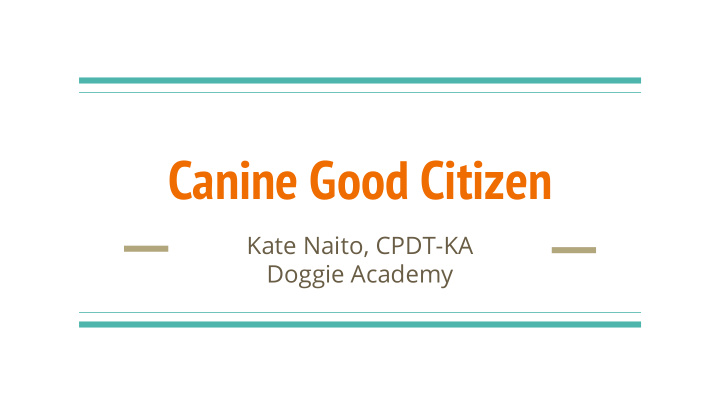



Canine Good Citizen Kate Naito, CPDT-KA Doggie Academy
TEST: TASKS 1-3 1. Accept a Friendly Stranger • Stranger does not interact with dog • Handler can’t hold back a jumpy dog 2. Sit Politely for Petting • Dog doesn't need to stay still but must be under control 3. Appearance and Grooming • Evaluator gently brushes, gently examines ears, and picks up feet
TEST: TASKS 4-6 4. Loose Leash Walk • Must have a right turn, left turn, about turn, stop in between, stop at end 5. Walk Through Crowd • No jumping, straining, hiding during walk 6. Sit/Down on command. Stay. • Stay: okay if dog changes position, but can’t start walking
TEST: TASKS 7-9 7. Come When Called • Handler walks 10 feet away and calls dog 8. Reaction to Other Dog • Handler approaches and shakes hands with person who approaches with dog. Then continue walking. 9. Reaction to Distraction • 2 distractors: one visual, one auditory
TEST: TASK 10 Supervised Separation • 3 min. Dog cannot see owner. • Mild anxiety is acceptable.
Mark and Reward Tell your dog when he’s done the right behavior: 1. “Mark” the behavior Say “Good dog!” or “Yes!” the second he does the right thing. 2. Reward the behavior Give treat or toy. Don’t be stingy! This encourages the dog to do the behavior again.
Reward for Eye Contact Your dog should learn that looking at you brings great rewards. This keeps him under control in various situations. Practice “Watch Me”: 1. Bring treat near your eye. When dog looks at your face, Mark and Reward. Practice until dog “gets it.” 2. Add cue “Watch me” before you make the gesture. Practice 4+ times. 3. Say “Watch me” and move your hand away from your face. Mark and Reward the second your dog (finally) looks at your face, not the hand.
#1: Accepting a Friendly Stranger For shy dogs: • Perform Stay / Shake / Bow For jumpy dogs: • Jumping never gets rewarded with petting • Sit for all greetings
#2: Sit Politely for Petting Dog doesn't need to stay still, but must be under control For shy dogs: • Pair treats with petting. Give treat before dog gets worried. For jumpy dogs: • Jumping never gets rewarded with petting • Sit for all greetings
#3: Appearance and Grooming Dog must be appropriate weight, healthy, and well groomed. Evaluator gently brushes, examines ears and picks up feet. Mild squirming okay, but dog should not resist touching. For uncomfortable dogs: • Pair treats with petting. Give treat before dog gets worried. • Perform Stay or Shake
#4: Loose Leash Walk OK to talk to dog, or ask to sit at the stops Excessive pulling or sniffing, inability to change directions with handler = fail Training to help: • “Touch” / “Watch me” / Dog pulls, you stop
#5: Walk Through a Crowd OK for dog to briefly sniff or acknowledge people, but must move on No jumping, straining, hiding Training to help: • Leave It / Hand Target / Watch me / Stop if pulling
#6: Sit. Down. Stay. Stay: Handler walks away 20 feet and returns to dog to release. Training to help: Stay with gradually increasing distance. ● Say “Stay” and show hand signal. ○ Take one step away. Turn your back on dog. ○ Return to dog. Mark and reward while dog is still in Stay. ○ “Okay” to release. ○ Repeat, but take two steps away. ○
#7: Come When Called Handler walks 10 feet away and calls dog. Training to help: • Hand Target • Restrained Recall with collar grab
#8: Reaction to Other Dog Dog must not cross over handlers to get to other dog. Dog must not follow other dog. Training to help: - Counter-condition to other dogs - Sit/Stay / Watch me / Hand Target
#9: Reaction to Distraction Dog must not panic, eliminate, growl/lunge, bark more than once or twice. Training to help: • Handler can get dog’s attention throughout distraction with “Watch me” or other command.
#10: Supervised Separation OK = some walking back and forth, mild vocalizations Fail = continual crying, agitated pacing, panting, pulling, eliminates Training to help: • Stay with distance • Act casual when leaving and returning your home • Each time you practice, start 10-15 seconds less than your dog can comfortably do. Keep sessions short and fun.
Recommend
More recommend